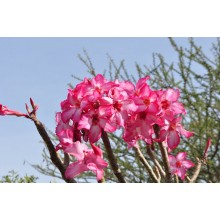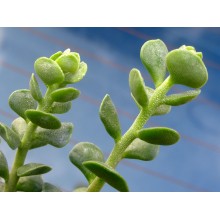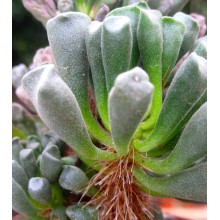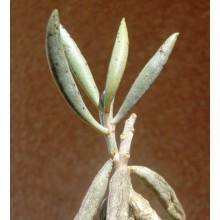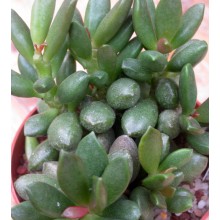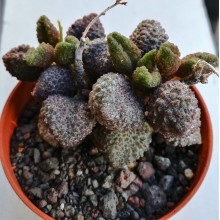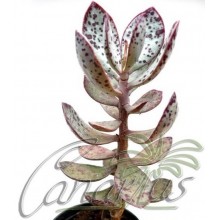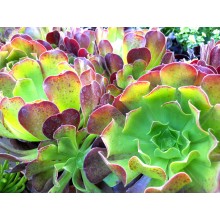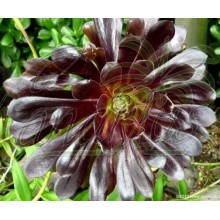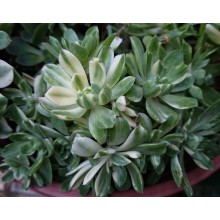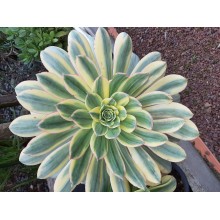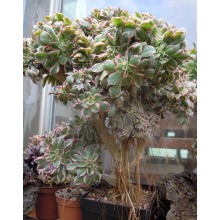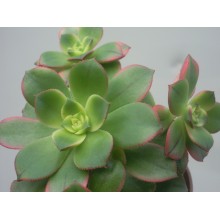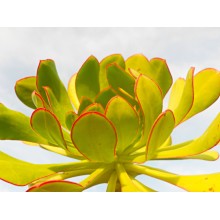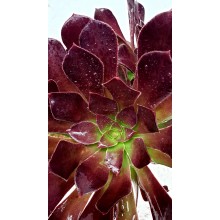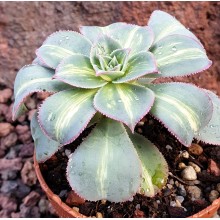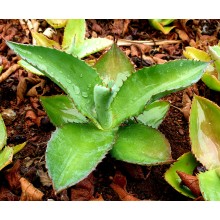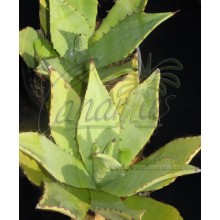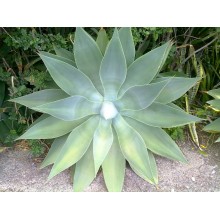Succulente Ci sono 628 prodotti.

I deserti del mondo e le zone secche ospitano le piante più interessanti. Canarius offre una selezione crescente di piante succulente di massima qualità, perché sono coltivate all'aperto, in pieno sole delle Isole Canarie.
I succulente o "piante grasse" sono specie di ritenzione di acqua, adattate alle condizioni di asciutto. Loro accumulano succum (succo, acqua) nelle loro foglie, steli o radici, e spesso mostrano un aspetto robusto e carnoso.
Sotto-categorie
-
Agave
Agave è un genere di piante grasse provenienti dall'America. Alcune specie crescono in zone fredde e possono sopportare un forte gelo, mentre altri vivono in climi tropicali. Alcuni sono piccoli nani e alcuni sono giganti, fino a 2 o 3 m di larghezza.
Le agavi resistenti al freddo possono creare un effetto esotico nel vostro giardino. Le specie agave fanno bella compagna di palme o cactus. Le agavi variegate sono incredibilmente ricercati dai collezionisti. Il nostro negozio web offre una selezione in continua evoluzione delle specie. Spediamo piante a radice nuda, se non diversamente specificato.
-
Aloe, Gasteria & Haworthia
Aloe, Gasteria e Haworthia sono tre generi correlate, comprese centinaia di piante succulente. Sono tutti facilmente coltivate in vaso. Alcuni si adattano a bassi livelli di luce di condizioni interne e possono essere coltivate come piante da appartamento.
- Aloe è un genere di circa 400 specie, originarie di Africa, Arabia e Madagascar. I aloe piccoli o nani stanno diventando particolarmente popolare in climi più freddi in quanto possono essere presi in casa durante i mesi più duri.
- Gasteria comprende circa 80 specie endemiche in Sud Africa, conosciuti per le loro foglie spettacolari che sono lucide, screziati e ruvidi. Fioriscono in primavera-estate con lunghe punte di piccoli fiori arancioni. Alcune specie sono talmente variabile che offriamo cloni particolari di località specifiche.
- Haworthia è un genere endemico in Sud Africa con circa 70 specie e un certo numero di sottospecie locali, varietà e forme. Le foglie sono spesso banded, punteggiati, punteggiato, o semi-trasparente e mostrano ampie variazioni.
-
Crassule
Questa è una nuova e crescente sezione di specie della famiglia Crassulaceae. Ci sono circa 1.400 specie in 33 generi et la loro distribuzione è in tutto il mondo, ma si presentano più nell'emisfero Nord e Sud Africa, in particolare in ambienti asciutti. Qui si possono acquistare piante sani, indurito dal sole, coltivati nelle isole Canarie e spediti a casa tua.
-
Mesembriantemi
Questo gruppo di piante del deserto è chiamato Mesembriantemi perché appartengono a una famiglia botanica precedentemente denominata Mesembryanthemaceae. Ci sono quasi 2.000 specie, che si trovano principalmente in Africa del sud, con adattamenti estremi agli habitat secco. Alcuni sono chiamati "pietre vive", perché sembrano come ciottoli. Molti sono facili da coltivare e il loro bisogno principale è pieno sole. Alcuni sono difficili perché crescono nelle aree veramente estreme.
Il nostro Web Shop offriamo piante sane coltivate al sole, con foglie compatte e colorate. Alcune piante sono venduti come talee, e altri come piante radicate, di almeno due anni. -
Sansevieria
Recentemente assegnato alla famiglia Asparagaceae, il genere Sansevieria conta circa 70 specie, quasi tutti nativi in Africa, Arabia e Madagascar. Erbe perenni adatti per gli habitat secchi con foglie rigide, succulente, la loro lunghezza varia da pochi centimetri a 2 metri. Sansevieria trifasciata e le sue numerose cultivar sono tra le piante d'appartamento più apprezzati, popolarmente chiamata la lingua di suocera. Una pianta ben coltivata di solito produce un picco di molti fiori bianchi, riccamente profumati e poi bacche arancioni. Anche le specie più rare sono resistenti ad abbandono, a condizione di tenerli dal gelo in inverno e sole cocente in estate.
-
Hoya
Le Hoyas sono rampicanti, dai fiori esotici e spesso vistosi. Provengono dalle foreste pluviali in Asia e Oceania. La maggior parte delle specie vive bene a mezz' ombra e si adatanno a vivere in casa come piante da appartamento. Sono ideali per cesti e tralicci. Tollerano un paio di settimane di siccità, ma sono sensibili al gelo e freddo. Molte hoya i sono facili da far crescere e fiorire, mentre alcune sono difficili e rare.
-
Asclepiadaceae
Le Asclepiade, o Asclepiadoideae, sono una sottofamiglia delle Apocynaceae, che annoverano circa 2900 specie diverse. Tra queste si trovano molti fusti privi di foglie ma anche erbe perenni, arbsuti, liane e, raramente, alberi. Producono fiori molto belli, dato il complesso sistema di impollinazione. Molte specie producono un odore insolito, spesso associato a quello di una carogna, la cui funzione è quella di attrarre le mosche che poi andranno a impollinare i fiori. -
Caudiciformi
Queste piante, dette anche pachicauli, sono tipiche delle zone aride. Producono un tronco insolitamente grosso e sproporzionato, detto caudice (a volte anche tubero), spesso con ramificazioni. Il caudice può essere anche nascosto sottoterra, ma nella maggior parte dei casi ha sviluppo verso l'alto, dando luogo ad alberi dalla forma spettacolare. I caudiciformi più grandi sono i baobab. -
Altre succulente
Qui troverete tutte quelle specie di piante del deserto che non sono inclusi nella propria categoria. Metteremo qui tutte le piante provenienti da famiglie inusuali, diversi da Agavi, Aloe, Crassulaceae, Sansevieria, Mesembriantemi, Epiphytic cacti, etc.
-
Adenium somalense- Large 3
Adenium somalense- Large 3
Adenium somalense is one of the most beautiful caudiciform plants. It grows wild in Somalia and through the Rift Valley into Ethiopia, Kenya, and Tanzania. Depending on the area, its trunk can take different shapes from a fat shrub to a small tree (more than 4 m), differently from the similar species A. obesum whose caudex is mainly underground. The showy...
75,00 € -
Adromischus caryophyllaceus CG62 Robertson
Adromischus caryophyllaceus CG62 Robertson
Beautiful Adromischus with erect branches and round-spathulate leaves, coated with a blueish-grey wax. It bears in summer relatively large flowers with purple mid-stripes.This clone was collected in Robertson, in the Western Cape and recorded as CG62.
10,20 € -
Adromischus cooperi
Adromischus cooperi
Large, branched, cont.= 8,5 cm - A slow growing South African species with swollen purple leaves, with grey-purple blotches, and undulating leaf apex. It will enjoy some light shade in the hottest months.
12,20 € -
Adromischus cristatus var. clavifolius
Adromischus cristatus var. clavifolius
Large, Branched Plant - Easy but slow South African succulent with "hairy" stems. These hairs are showy reddish-brown aerial roots. This clone has spathulate leaves with apical margin undulate.
10,20 € -
Adromischus filicaulis ssp. filicaulis
Adromischus filicaulis ssp. filicaulis
This Adromischus has long grey leaves, more or less spotted, on erect stems. It is another variable species of this interesting genus.
10,20 € -
Adromischus mamillaris
Adromischus mamillaris
This is a low-growing Adromischus, densely branching, with grey-green pointed leaves, only mildly mottled. This South African species has the widest geographical distribution in the genus.
10,20 € -
Adromischus marianae v. herrei
Adromischus marianae v. herrei
Weird beauty from the South African desert. It is a must for collectors of Crassulaceae or extreme succulent plants. This Adromischus has short dark leaves with an incredibly rough surface which is a masterpiece of nature. It changes colours through the seasons from green to brown, red or more.
12,30 € -
Adromischus triflorus
Adromischus triflorus
Pot = 8,5 cm. Variable species native to South Africa. It forms clusters with thick, silvery green leaves. This form has ovate-pointed leaves with abundant reddish speckles, tending to become more intense in bright light.
12,20 € -
Aeonium arboreum cv. Purpureum
Aeonium arboreum cv. Purpureum
A garden selection with leaves stained with purple tips and spots.
10,20 € -
Aeonium arboreum cv. Zwartkop
Aeonium arboreum cv. Zwartkop
h= 10 cm - Cont.= 8,5 cm. The black aeonium is an old classic cultivar. Rosettes have burgundy-black leaves and the bright yellow inflorescence make a showy contrast.
11,80 € -
Aeonium castello-paivae cv. 'Suncup
Aeonium castello-paivae cv. 'Suncup
Robust, rooted, unbranched plant. An incredible rainbow of colour! This aeonium is the boldest of all. Each leaf has a painting of dark green, jade, white and pink.
11,20 € -
Aeonium cv. Sunburst
Aeonium cv. Sunburst
Robust, rooted, unbranched plant. An incredible rainbow of colour! This aeonium is the boldest of all. Each leaf has a painting of dark green, jade, white and pink.
10,20 € -
Aeonium decorum f. cristata variegata
Aeonium decorum f. cristata variegata
Variegated AND crested. This plant is truly unusual and will slowly become a bonsai-like tree structure. The natural form of this species is originally native to the Canary Islands.
10,20 € -
Aeonium decorum tricolor 'Kiwi'
Aeonium decorum tricolor 'Kiwi'
Colourful selection of a branched Aeonium, with "rainbow" rosettes. Easy growing, it is probably a clone of the widespread A. decorum, native to the island of La Gomera, in the Canary Islands.
10,20 € -
Aeonium urbicum
Aeonium urbicum
Beautiful succulent plant endemic to Tenerife. This species of Aeonium does not branch, it grows upright and it bears a huge piramidal inflorescence. "Urbicum" means "urban", because it is often seen growing among tiles on the roofs of the city of La Laguna, in an "urban environment".
10,20 € -
Aeonium x 'Blushing Beauty'
Aeonium x 'Blushing Beauty'
Colourful classic hybrid, germinated in 1976 in Southern California by Jack Catlin, who crossed Aeonium canariense with Aeonium arboreum 'Zwartkop'.
10,20 € -
Aeonium x 'Lemon and Lime'
Aeonium x 'Lemon and Lime'
h= 10 cm - Cont.= 8,5 cm. It is a spectacular American hybrid of Aeonium decorum. It is characterised by the yellow band along the centre of its leaf. It ends with pink serrated edges. The rosette can be up to 30 cm wide.
15,30 € -
Agave abisaii
Agave abisaii
New Agave species described in 2013 within the "marmorata group".
21,30 € -
Agave albescens
Agave albescens
One of the few grey leaved agaves from the Caribbean islands. Mid-sized elegant rosette, with grey-yellow leaves and dark spines. It is an uncommon species endemic to the rocky hills of SE Cuba. It can be kept small in a pot for years.
21,30 € -
Agave attenuata ssp. attenuata
Agave attenuata ssp. attenuata
Cutting of 10-15 cm diameter. A classic of all times in subtropical gardening. It is a mid sized spineless agave native to the cooler plateau of Central Mexico. Rosettes achieve 1 m (3 ft) with spectacular wide, green-blue waxy leaves.
19,80 €
Al momento ci sono pochi prodotti in questa categoria Succulente

























